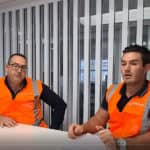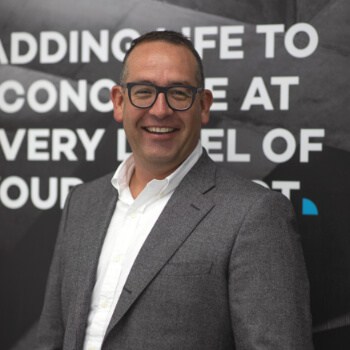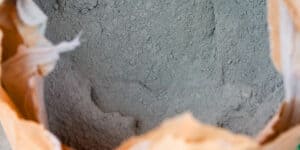BRENDAN: Kia ora and g’day everyone, welcome to Markham’s latest podcast episode. I’m Brendan Stead, Markham’s marketing coordinator, and it’s great to have you listening today.
In this remarkable episode we’re going to hear – how does AQURON work? AQURON concrete hydrogel treatment is at the core of Markham’s suite of multi-benefit concrete treatments. What you are about to hear was originally recorded for the purpose of training our own applicators. We’ve decided to release this to a broader platform to help with the industry’s understanding of a very unique family of concrete treatments. Hydrogels do not coat the surface – they cannot be seen once treatment is complete – their effect is invisible: INVISIBLE STRENGTH.
I give you Doug McKenzie, Markham’s key application technician in Auckland New Zealand, and Mark Smith, CEO of Markham.
DOUG: So Mark, tell me – why is Aquron unique? What makes it unique?
MARK: So the main thing is it’s a hydrogel. So it’s a complex product with a unique catalyst that makes it penetrate into concrete. And it is a colloidal silica which has very, small nanoparticles. Colloidal silica – it sounds very fancy, but colloidal water is fog, so all it means, colloidal just means a whole lot of particles in suspension that are ready to attach to something or chemically bond to something. So, with AQURON, we’re not just a colloidal silica, we have a unique catalyst that makes it penetrate into the concrete. And it’s not just penetrating down, like by gravity – it’s actually molecularly attracted to the concrete. And we would expect that the range of penetration can range anywhere from 100 to 150mm or even further. And we’ve seen it go up into the underside of concrete, or soffits; we’ve seen it go sideways into walls; and we’ve obviously seen it go down into 100s and 1000s of slabs. But what makes AQURON the most different is actually the unique catalyst.
Lots of people can provide a silicate – a lithium silicate or sodium silicate – but we are colloidal silica, which means we’ve got very, very fine nano-sized particles. And to put a bit of perspective around that, it’s like saying – if you said the porosity into the concrete was the width of a road, then the nanoparticle would be about the size of a human, so that’s how easy it is for it to travel down the through the porosities.
DOUG: OK, so that gives us a bit of a perspective on the size of the particle. OK. Mark, how did AQURON come across this unique catalyst?
MARK: Well the founder, Ken Solomon of Aquron Inc, started off when he left school, as a lab technician, just a junior lab technician, working in the space program for Martin Mariatta Corporation. Now a lot of us don’t understand that the space program has affected a lot of things in our actual everyday life. OK, what he was originally involved in, with a very high up Professor, was actually helping, by catalysts and nanoparticles, force the silicone into the ceramics that are used on the external of the space shuttle. That’s what they were doing.
But that actually went on to have a lot of different things in life, and it’s not only limited to this. But one of them, real basic, is your bread bag. Back in the day you used to have no such thing as a central bakery, you had your local bakery that you went down and got your bread each day and you came along back with a paper bag. Well, central bakeries started, and they started using plastic bags. But the problem is, they couldn’t get any ink to stick that would go on to have hot bread in it, cool down with moisture, then maybe put in a fridge or maybe put into a freezer, maybe just left out, all those different temperature zones. So they actually used the same principle – not the same catalyst, but the same principle – to actually infuse the ink into the bread bag.
So time went on, and he left that job, and he went through a number of different roles, and finally, in the late ‘70s he bought a waterproofing company. And he was continually going back and re-applying annually, silanes and siloxanes because they would continually break down. So at the end of the day, he went back to his Professor and said, Why can’t we get a product that will go into concrete, that will penetrate and stay there and be permanent? That was the original thought. So the original thought, he went back to that Professor, they came up together with the unique catalyst – which is a secret! It’s never been patented, no one else knows what that is – I don’t know what it is. But all I do know is that on the 100s of 1000s of square metres that I’ve seen personally, I’ve seen it go up into concrete, I’ve seen it go through concrete, I’ve seen it go down into concrete, it’s not gravity reliant. It is the unique catalyst that makes AQURON the main point of difference.
DOUG: Awesome! So Mark, we’ve obviously got a whole different array of products here at Markham. Tell me a little bit about the difference – what they are, what the differences are between them as well.
MARK: Well, the first product that AQURON came out with was the AQURON 2000. That is the hydrogel product that has the unique catalyst that transforms moisture from a liquid into a hydrogel. That is used for waterproofing, moisture protection under floor coverings, durability, curing, hardening, anti-dusting, or a combination of any of those things. So they had that product – that is their first and original product, and the base product also for AQURON 7000.
Now AQURON 7000 is AQURON 2000 with a corrosion inhibitor. Why you use AQURON 7000 is in places where there’s already existing corrosion, like chlorides are in there or there’s an acidic environment, carbonation or something like that.
DOUG: So marine-type environments?
MARK: Marine-type environments, yes.
The next product they came out with was AQURON 300 which again is actually a hydrogel. But it is mixed in at the concrete plant so we’ll talk about that separately.
It wasn’t until Markham came along in 1996 that we asked for them to develop the AQURON 1000. Now AQURON 1000 does all the curing, hardening and anti-dusting benefits of AQURON 2000 but it doesn’t provide guaranteed waterproofing or moisture protection like the AQURON 2000 does. So it uses the unique catalyst but it uses some New Zealand or Australasian-sourced ingredients to provide the hydrogel.
So in short, AQURON 7000 will do the job of AQURON 2000 or 1000 but you can’t do it the other way round.
The other product that has come on line in the AQURON range is the AQURON 2000 MEDI+. Again, like the AQURON 7000, it uses the standard AQURON 2000 as a base. And it has an extra acrylic-modified additive which helps it give some extra protection to the surface to those hygiene environments like aged care or medical.
The only other product which AQURON actually does do is the AQURON 1200 which is not one of the hydrogels. It is purely just a surface hydrophobic product that makes a water repellency on the surface.
So, the 7000, 2000, 1000 and MEDI are all the hydrogels with the unique catalyst that we spray on. The 300 is an additive that mixes in. The 1200 is a surface-applied hydrophobic only.
DOUG: Interesting! So Mark, we know what AQURON does, but how does it do what it does in terms of getting into the concrete matrix? Is it a topical coating? Is it something that absorbs? Maybe just tell me a little bit about that.
MARK: OK so firstly what I want you to think about – we all agree that ancient Egyptians were preserved by embalming.
So AQURON, forming a hydrogel inside the porosities of the concrete is effectively embalming the inside of the concrete. We are not a membrane. We are not a topical coating. We are internally, inside the concrete, penetrated in or added in by the admix, depending on which one you use. The fact of the matter is we’re inside the concrete. Now we all know if you just put a topical coating or sealer or whatever on the surface of the concrete – it’s no different to you wearing a raincoat on a rainy day, you still sweat inside your raincoat. Well a concrete bridge or a concrete structure, or whatever, sweats underneath – so they’re not stopping the moisture movement.
Now it’s internationally recognized, no one can dispute this, that if you stop moisture movement you stop corrosion. You also stop the problems of flooring delaminating, and all those different things. If you stop the moisture movement in concrete you also get a better cure.
At the end of the day – real simple, break it down, however technical or scientific you want to get as to how it does it, the actual overriding principle is that it is effectively embalming the concrete.
Now I probably should show you on a whiteboard how it actually does it, because it’s not just break open the concrete and you see something foreign in there. The hydrogel actually forms a calcium-silicate-hydrate. Now calcium-silicate-hydrate is actually what forms from cement when it binds concrete together. So that is why we say AQURON is compatible with anything that’s compatible with concrete, because we’re effectively not putting in anything different than what is put into a standard concrete.
DOUG: That’s already there.
MARK: We’re forming a hydrogel, we’re embalming the moisture inside the concrete, and that means the moisture can still be used so the concrete can strengthen – because that’s another part, that people often think, “Oh well if we hold the water in, it won’t strengthen.” That’s still got access to be able to help those calcium-silicate-hydrates form to their maximum strength.
But in short, AQURON hydrogels are a colloidal silica, a small nanoparticle, a unique catalyst, that go into the concrete and form a calcium-silicate-hydrate in the form of a hydrogel that what? – embalms the concrete. It’s really easy – just think embalming the concrete.
Let’s just re-cap. So AQURON as a colloidal silica which just means nanoparticles in suspension – it happens to be in water. It has a unique catalyst, that once it goes into the concrete it forms a hydrogel which is a calcium-silicate-hydrate that transforms the way moisture is held inside the porosities. That’s the technical way, but just think embalming.
So, with the AQURON, to help you understand it, I actually want to go back a little bit to how the concrete structure works, because if you understand how the concrete structure works, it’s much easier to understand how the actual AQURON then comes in and works at a later date.
So let’s start off. We all agree that concrete has water in it. It has cement in it. It may have some additives in it as well. It has sand, and it has aggregate. So they’re the – you can’t have concrete if you don’t have concrete unless have those things in it. There may be other things but that’s the basic, basic concrete. So what a lot of people don’t understand is that 100% of the water that goes into the concrete, only a small percentage of that is needed to make cement react. And when cement reacts with water it forms calcium-silicate-hydrate, which I’ll come back to in a minute. But of that water – and every mix is different, but of that water, of 100% of the water, only a small percentage is used for the use of turning of dry cement into calcium-silicate-hydrate. The balance of it is used, goes out as bleedwater. Now bleedwater creates the porosities in the first place.
And the balance of that is left over as relative humidity, which is the stuff that either cures concrete, or is actually the same stuff that’s a problem for moisture underneath floor coverings on new concrete.
So that if we then go on to the next step, as to how do the porosities form. You know how I said to you, out of 100% of the water, only a small percentage is used for the use of turning the cement. So the rest of it is just there for making concrete workable, so you can get it out of the truck onto the ground. So when you get it on the ground, you’ve got sand, aggregate, cement, and water, on the ground. And boom, that’s heads down, you start finishing, screeding it off. As soon as that process starts happening, what happens is the porosities start getting formed by moisture moving to the top surface, and it comes out as bleedwater. You’ll see that in every concrete. That’s why they try and reduce the amount of water, so that you’ve got less porosity in the first place. So there’s always going to be some – you can’t make concrete without having some forming of porosity.
So just as a quick rule of thumb, and this is very basic level, but it is all true principle. The bottom third has its own moisture. The middle third has its own moisture plus stuff from the bottom. The top has its own plus stuff from the middle and stuff from the bottom, so the top effectively has three times as much porosity as the bottom does. So that’s why we ask the applicators to read concrete. It’s not just, AQURON goes on and is a one-coat or two-coat wonder. You’ve got to read the concrete to satisfy the absorbency of the concrete. So you could have the same concrete from the same concrete plant – I mean the same MPa from the same concrete plant, placed by the same finishers, one done with a burnished finish and one done with a broomed finish, and you could get completely different coverage rates. Because you’re reading the concrete for what it needs to satisfy its absorbency. Why? Because – say a broomed finished concrete, or very raw finished concrete, will have a lot more surface porosity to fill. It will have the same down the bottom …
DOUG: Because it’s rough?
MARK: Because it’s rough. Whereas if you go across and densely burnish it, you’re going to have a whole lot less of that, that’s why you’re going to use less AQURON.
But at the end of the day, AQURON works in the porosities of the concrete, it’s not on the surface, and it is working in the areas where the porosity was originally made by the moisture escaping via the bleedwater.
DOUG: So we make use of these porosities and channels to get our AQURON going?
MARK: Absolutely!
BRENDAN: So there you have it, folks. A unique look at a unique family of concrete treatments.
I’d like to thank Mark Smith and Doug McKenzie for their valuable input into this segment – no doubt you’ve found it informative and valuable.
If you want to find out more, please go to our website, www.markhamglobal.com. We do our best to respond to all enquiries within a business day.
We are also happy to take suggestions for podcast topics in the future. What are your concrete pain points in the field? How can we help to educate the industry?
Thank you so much for listening, and don’t miss our next episodes!






